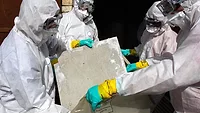Hidden Hazards in Floods: Asbestos

As with any water damage project, when you respond to a flood event, you will want to begin by helping your client develop a list of actionable items such as filing an insurance claim or other recommendations that not only set expectations for the project moving forward but also encompass both health and safety. As such, don’t forget to include an asbestos survey in your plan. Flooding isn’t just a matter of water damage and biological contaminants; rather, it may also loosen and dislodge other fibrous particles that are hazardous to you or your client's health. If the flooding process does not, it is likely that the water restoration and demolition efforts will.
A Question of Construction
Asbestos has been used in construction and insulation products for decades, with the height of its use occurring prior to the 1970s. And while asbestos is regulated today as a result of the risks inherent in exposure, it is not banned in the United States and the regulations in place today did not remove legacy asbestos.
Consequently, asbestos may exist throughout your client’s property — especially if the home or business was constructed prior to the Environmental Protection Agency’s (EPA) initial crackdown on the substance in the 1980s.
According to the U.S. Consumer Production Safety Commission (CPSC), you can expect to find asbestos primarily in …
- Roofing materials
- Insulation materials
- Textured paints and patching materials
- Within walls and flooring
- Around pipes and plumbing, etc.
Opening the Floodgates
While asbestos is relatively benign so long as it is in tact and undisturbed within a structure, it becomes incredibly hazardous once exposed and rendered airborne. In particular, the U.S. Department of Health and Human Services recognizes asbestos as a human carcinogen, meaning it is capable of causing cancer (and other upper respiratory conditions) in individuals who have been exposed to it. Thus, flooding and water damage restoration activities can displace and disturb asbestos, posing a threat to the building’s residents as well as workers who may come to remediate the site. Homes and businesses on The Gulf and East Coast that are prone to hurricanes may be especially vulnerable to asbestos exposure, especially during hurricane season.
When Asbestos Action Is Inevitable
When conducting water damage restoration on buildings that have experienced a water loss event, in many cases demolition must occur in order properly sanitize the structure. Prior to conducting any demolition or remediation activities, you should check your local, state, and federal regulations in regards to asbestos.
In the health and safety chapter (chapter 8) of the current ANSI S500 Standard and Reference Guide for Professional Water Damage Restoration, it mentions that, “Even if the building owner has a survey for asbestos, the restorer is still responsible for identifying and controlling asbestos exposure during demolition and removal of materials.” It is possible that the survey your client had conducted was a limited survey isolated to only an area that was being remodeled or renovated and did not encompass the area at which you are working. Its for this reason, and in accordance with the prevailing industry standard that you should never take their word for it.
Both the OSHA construction standard 29 CFR 1926.1101 and the General Industry Standard 1910.1001 shall be followed whenever presumed asbestos is present. All that to say, it's best to follow the law and get a survey before proceeding with the mitigation.
Onward To Recovery
So, now that we have established that with flood events there are more hazards than what meets the eye, it is imperative that we close this out with the importance of health and safety in these flood events. Many times during catastrophic flooding events or overnight emergency calls it is all too easy for health and safety measures to be dismissed in an effort to expedite the process to return your client back to normal - get in, save the day, get your client back to normal, on to the next one. As professionals it is also our duty to uphold and adhere to federal laws, standards, and regulations within our industry.
To learn more about asbestos hazards and techniques for remediation, click here
Your clients and your employees are not only trusting you to do the job correctly, they are also trusting you with their health and safety throughout the process. Before we go in, and get to work, let’s take the time to identify, establish, and account for potential hazards, so that way our clients can move onward to recovery with no hidden hazards or risks moving forward.
Looking for a reprint of this article?
From high-res PDFs to custom plaques, order your copy today!







